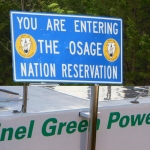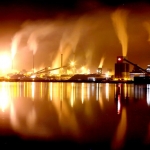US: Alaska's Air Sullied by Oil Production
Scan the landscape surrounding Alaska's northern oil fields and you won't see much obvious pollution.
Litter is scarce. Pipeline leaks, like the one that shut half of the Prudhoe Bay oil field this month, tend to be small. An intricate network of pipes crosses the land, but much of it hangs suspended several feet above the tundra, propped up on supports.
Yet the North Slope operations -- like oil production facilities everywhere -- taint the environment in a more substantial, but invisible, way.
They release into the air a steady stream of pollutants and greenhouse gases, spewed by vehicles, power generators and the drilling process itself. Estimates vary, but the North Slope oil fields probably produce more smog-forming nitrogen oxides than Washington, D.C., and more carbon dioxide than San Francisco.
Air pollution, to a certain extent, is an inevitable product of any large industrial operation, just as it is with a city. Air pollution on the North Slope, home to herds of caribou and vast flocks of migrating birds, riles some environmentalists but rarely gets the attention of people outside Alaska, even those caught up in the debate over expanded drilling in the Arctic. Spills and caribou are easier to understand -- and make better photos.
Environmentalists insist that air pollution must be part of the debate over drilling in the Arctic National Wildlife Refuge.
"The difficulty with air pollution is it's not tangible unless there's black smoke," said Mike Frank, senior staff attorney with the Trustees for Alaska environmental law firm. "It's difficult for people to get their minds around as an environmental problem. But it's probably more intractable and more difficult to deal with than oil spills, at least spills on land."
The state of Alaska recognizes the pollution, but says the oil companies are staying within government-imposed limits. And those limits should protect the health of the people who live on the slope.
"As far as the department can tell, the companies are generally in compliance with their legal limits or taking steps to correct any exceedances," said John Kuterbach, air permits program manager for the Alaska Department of Environmental Conservation.
Oil standards met
A spokesman for BP PLC, which runs Prudhoe Bay, said the company has complied with pollution limits that "should eliminate health risks associated with air emissions from our facilities."
ConocoPhillips Inc. spokeswoman Natalie Knox said the company had recently agreed to use lower-sulfur diesel in its North Slope vehicles as a way of cutting pollution. The company monitors pollution levels in the area.
"Monitoring indicates that the air quality on the North Slope is consistently better than national standards," Knox said.
Pollutants that can harm human health aren't the only issue. The oil field operations pump the greenhouse gases carbon dioxide and methane into the air, contributing incrementally to global warming -- which is having serious effects in the Arctic, where permafrost is thawing and sea ice is melting ever earlier.
"We're at ground zero here in Alaska," said Pamela Miller, Arctic coordinator for the Northern Alaska Environmental Center in Fairbanks. "We're already seeing changes in the plants, the wildlife, the ocean. To add even more greenhouse gases here just doesn't make sense."
The exact amount of emissions on the North Slope is difficult to determine.
The state doesn't measure air pollution from the oil fields. Instead, it calculates estimates based on data submitted by the oil companies.
Complicating matters, currents of air in the atmosphere take some pollution generated in lower latitudes -- the lower 48 states, Europe and Asia -- and dump it in the Arctic. In other words, the air over Prudhoe Bay likely contains pollution from faraway sources as well as from the oil field itself.
Data from the Department of Environmental Conservation suggest the North Slope operations each year emit about 41,408 tons of nitrogen oxides and 779 tons of sulfur dioxide, a key cause of acid rain. The department data also show 3,223 tons of particulate matter emissions, essentially, small airborne soot particles that can cause breathing problems.
Those numbers, however, do not include any mobile sources of air pollution, such as trucks, aircraft and drilling rigs. Environmentalists say the data also don't include several oil field facilities.
Other studies, from government and independent researchers, have arrived at different numbers, using several methods. Earlier state figures quoted by the National Academy of Sciences in a landmark report on the North Slope environment showed 70,000 tons of nitrogen oxides emitted in 1999, again excluding mobile sources and several oil field facilities. Another study quoted by the National Academy found 1,334 tons of sulfur dioxide and 5,400 tons of particulate matter emitted in 1994 and 1995.
Variety of statistics
Emissions of methane, a potent greenhouse gas, were estimated at 24,000 tons in 1995. As for carbon dioxide, the gas most frequently blamed for global warming, estimates vary widely. A 1995 study that calculated emissions based on the amount of fuel burned on the slope estimated 7.3 million tons of carbon dioxide were produced annually. A 1997 study in which researchers flew downwind from the oil fields suggested a far higher number -- 40 million tons.
By comparison, San Francisco emits about 9.7 million tons of carbon dioxide, almost 23,800 tons of nitrogen oxides and 540 tons of sulfur dioxides annually, according to city and federal data.
Just as in the Bay Area, the North Slope's air pollution sometimes becomes visible. The sight of it in a remote and largely pristine environment angers environmentalists.
"It's a band of yellowy smog," Miller said, "It's disturbing that with an oil field over a hundred miles away, you can see the effect on the horizon in what is normally a beautiful place."
State officials, however, say the air pollution appears to be within legal limits. The state grants permits for the amount of air pollution oil field facilities are allowed to emit. Although the emissions data the state uses are collected by the companies, they are reviewed by state workers, Kuterbach said.
The permit process itself has become a source of conflict. Environmentalists complain that the state looks at oil field operations piecemeal, considering emissions from individual facilities rather than the whole. That allows the government to avoid acknowledging the full extent of air pollution and applying more-stringent limits, environmentalists argue. A former permit manager for the state says he was forced out of his job for trying to make the same point.
Kuterbach says that viewing everything together would be too complex a process for the state to administer.
"If you considered it all in one plan, someone would have to know everything going on everywhere on the entire North Slope in order to determine permit compliance," he said. "It was just not a tenable solution."
Measuring results
The state's process, he said, should result in roughly the same amount of pollution allowed from the oil fields.
"The equipment you're going to need is going to be the equipment you're going to need, and the pollution it's going to emit is the pollution it's going to emit," Kuterbach said. "My gut feeling is there would not be a significant difference in emissions."
- 107 Energy
- 182 Health



